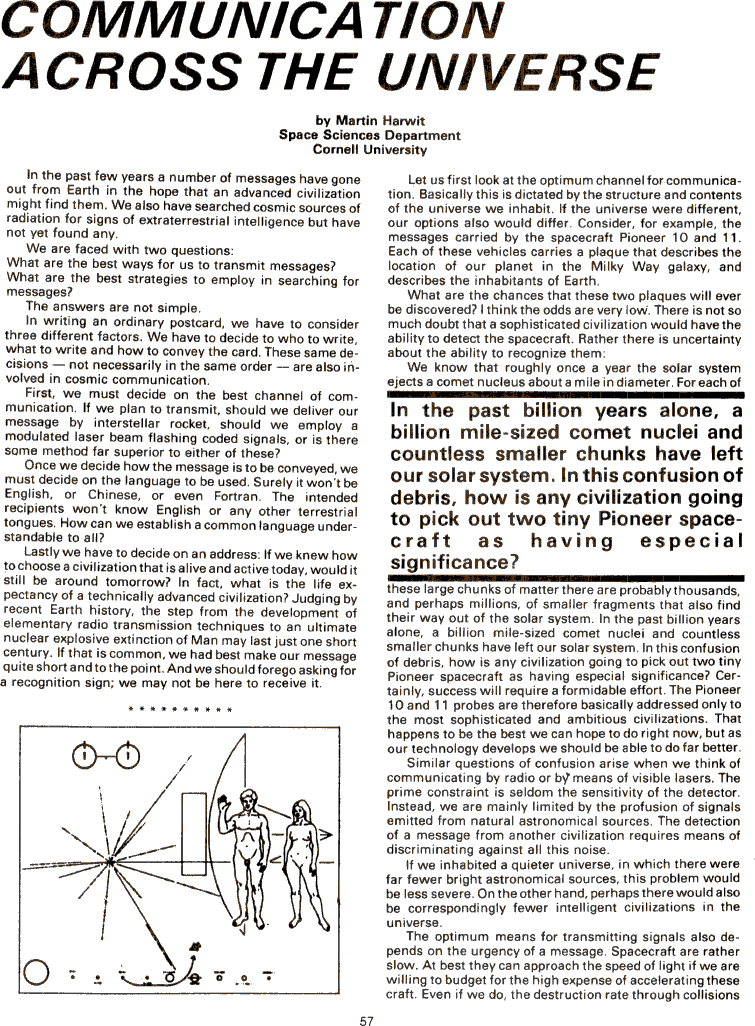by Martin Harwit

COMMUNICATION ACROSS THE UNIVERSE by Martin Harwit Space Sciences Department Cornell University In the past few years a number of messages have gone out from Earth in the hope that an advanced civilization might find them. We also have searched cosmic sources of radiation for signs of extraterrestrial intelligence but have not yet found any. We are faced with two questions: What are the best ways for us to transmit messages? What are the best strategies to employ in searching for messages? The answers are not simple. In writing an ordinary postcard, we have to consider three different factors. We have to decide to who to write, what to write and how to convey the card. These same decisions -not necessarily in the same order - are also involved in cosmic communication. First, we must decide on the best channel of communication. If we plan to transmit, should we deliver our message by interstellar rocket, should we employ a modulated laser beam flashing coded signals, or is there some method far superior to either of these? Once we decide how the message is to be conveyed, we must decide on the language to be used. Surely it won't be English, or Chinese, or even Fortran. The intended recipients won't know English or any other terrestrial tongues. How can we establish a common language understandable to all? Lastly we have to decide on an address: If we knew how to choose a civilization that is alive and active today, would it still be around tomorrow? In fact, what is the life expectancy of a technically advanced civilization? Judging by recent Earth history, the step from the development of elementary radio transmission techniques to an ultimate nuclear explosive extinction of Man may last just one short century. If that is common, we had best make our message quite short and to the point. And we should forego asking for a recognition sign; we may not be here to receive it. [Image] Let us first look at the optimum channel for communication. Basically this is dictated by the structure and contents of the universe we inhabit. If the universe were different, our options also would differ. Consider, for example, the messages carried by the spacecraft Pioneer 10 and 11. Each of these vehicles carries a plaque that describes the location of our planet in the Milky Way galaxy, and describes the inhabitants of Earth. What are the chances that these two plaques will ever be discovered? I think the odds are very low. There is not so much doubt that a sophisticated civilization would have the ability to detect the spacecraft. Rather there is uncertainty about the ability to recognize them: We know that roughly once a year the solar system ejects a comet nucleus about a mile in diameter. For each of these large chunks of matter there are probably thousands, and perhaps millions, of smaller fragments that also find their way out of the solar system. In the past billion years alone, a billion mile-sized comet nuclei and countless smaller chunks have left our solar system. In this confusion of debris, how is any civilization going to pick out two tiny Pioneer spacecraft as having especial significance? Certainly, success will require a formidable effort. The Pioneer 10 and 11 probes are therefore basically addressed only to the most sophisticated and ambitious civilizations. That happens to be the best we can hope to do right now, but as our technology develops we should be able to do far better. In the past billion years alone, a billion mile-sized comet nuclei and countless smaller chunks have left our solar system. In this confusion of debris, how is any civilization going to pick out two tiny Pioneer spacecraft as having especial significance? Similar questions of confusion arise when we think of communicating by radio or by means of visible lasers. The prime constraint is seldom the sensitivity of the detector. Instead, we are mainly limited by the profusion of signals emitted from natural astronomical sources. The detection of a message from another civilization requires means of discriminating against all this noise. If we inhabited a quieter universe, in which there were far fewer bright astronomical sources, this problem would be less severe. On the other hand, perhaps there would also be correspondingly fewer intelligent civilizations in the universe. The optimum means for transmitting signals also depends on the urgency of a message. Spacecraft are rather slow. At best they can approach the speed of light if we are willing to budget for the high expense of accelerating these craft. Even if we do, the destruction rate through collisions

